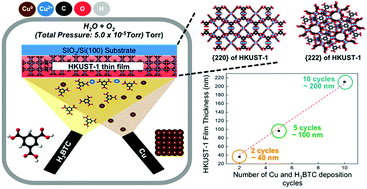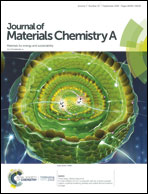Solvent-free vacuum growth of oriented HKUST-1 thin films†
Abstract
Thin films of ultrahigh porous metal–organic frameworks (MOFs) are highly desirable because the unique characteristics of MOFs could then be incorporated into micro-electronic devices, sensors, and membranes. Here we report a new thin film growth method for highly oriented Cu3(BTC)2 (HKUST-1) under vacuum without the use of solvents. Using layer-by-layer (LBL) growth, we sequentially deposited H3BTC from a chemical vapor deposition process and Cu from a physical vapor deposition process. Adopting this methodology, we grew thin films of HKUST-1 by sequentially depositing one monolayer (ML) of Cu after each H3BTC deposition cycle. The transition of Cu0 to Cu2+ by forming paddle-wheel units of HKUST-1 was confirmed by XPS, and is facilitated by background gas molecules, O2 and H2O, with no indication of copper oxide formation. Our HKUST-1 thin films have two distinct planes, the (220) plane detected by glancing angle XRD and the (222) plane identified by in-plane XRD, which indicates that the HKUST-1 thin films are highly oriented. Moreover, the thickness of the HKUST-1 thin films linearly increased with the number of LBL cycles by ∼20 nm for each LBL cycle as measured by AFM. Finally, we measured H2O desorption in a 100 nm HKUST-1 film and observed the existence of strongly bound H2O molecules absorbed within the HKUST-1 film, which predominantly desorb at ∼398 K. Overall, we show how to control the growth of highly oriented HKUST-1 thin films through a bottom-up approach by directly depositing H3BTC and Cu under high vacuum.



 Please wait while we load your content...
Please wait while we load your content...
